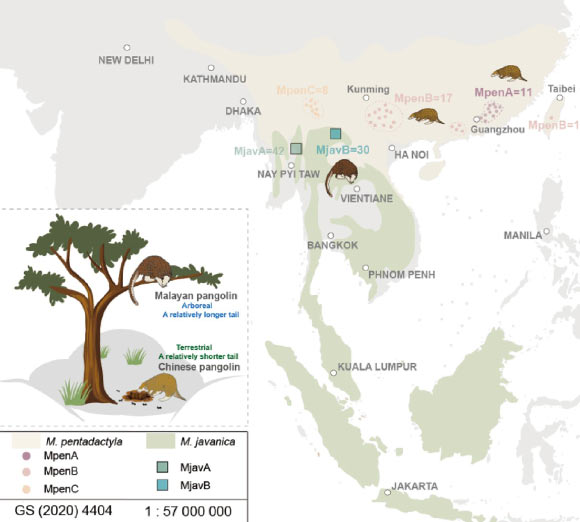
Cameroon timber
Researchers from Guangdong Academy of Forestry, Northeast Forestry University and their colleagues have assembled chromosome-scale genomes for two critically endangered pangolin species: the Chinese pangolin (Manis pentadactyla) and the Malayan pangolin (Manis javanica).
The distribution area and sampling sites of the Chinese and Malayan pangolins. Image credit: Lan et al., doi: 10.1093/gigascience/giaf003.
The pangolin is a living fossil with many unique biological characteristics, such as overlapping keratin scales covering the body, a specialized diet, a long and muscular tongue, a sensitive olfactory system, and burrowing ability.
Locals across its distribution areas have traditionally used its scales and meat for medicine and food.
The overexploitation of pangolins driven by the soaring demand for luxury food and traditional Chinese medicine has pushed this animal to the edge of extinction.
Currently, the pangolin is the most heavily trafficked wild animal worldwide, with more than 900,000 individuals poached over the past two decades and 67 countries from six continents involved in illegal poaching and trade.
Poaching is more rampant for Asian pangolins compared with African pangolins, particularly the Malayan pangolin and the Chinese pangolin, which are under extreme survival pressure because of significant poaching and trafficking.
These two species have been listed as Critically Endangered on the IUCN Red List since 2014.
“With World Pangolin Day being celebrated on February 15, it is befitting that new research presenting high quality genomic data for these Pangolin species puts a spotlight on the genetic vulnerabilities and extinction risks for Malayan and Chinese pangolin species,” said Guangdong Academy of Forestry researcher Yan Hua and colleagues.
The starting point for their analyses was generating genome sequences of the Chinese and Malayan pangolins at a significantly higher resolution than what is currently available.
Having such high quality data in the form of a nearly gapless chromosome-scale sequence is invaluable for obtaining essential information that are important indicators of genetic health and risk of extinction for any population.
For this, the analyses included genetic diversity estimates, which indicate how much genetic variation there is between individuals in a population.
The scientists then used the high quality data as a reference point, along with previously released genomic data from 37 Chinese pangolin and 72 Malayan pangolin individuals, to re-evaluate the conservation genetic status of five pangolin populations.
They found that the overall genetic diversity was surprisingly high — which is a positive sign for the genetic health of a population.
But, their fine-grained analysis showed that some of these populations are at a higher risk of extinction than the others.
Specifically, based on the genetic data for one pangolin population, the authors ascertained that this population had suffered a much faster and sharper population decline within the past 10,000 years compared with the other populations in their study.
Additionally, other genetic parameters in their study indicated this population in particular was at a very high risk of extinction.
Adding to this, their analysis of a pangolin specimen from Taiwan revealed similarly distressing data.
Future work is required to solidify the extent to which specific pangolin populations are at extinction risk due to serious survival pressures.
The data also indicate that further studies on the differences between the localities of these populations should receive more attention as they have the ability to aid in guiding the genetic rescue efforts that are already underway.
“In addition to aiding the management of illegal poaching and trafficking, the Chinese government has built a breeding center for the conservation of both Chinese and Malayan pangolins and has developed an artificial breeding and reproduction program,” said Professor Tianming Lan, a researcher at Guangdong Academy of Forestry and Northeast Forestry University.
“With the assistance of these data, we can better evaluate the genetic rescue strategies for wild populations by rewilding and releasing these captive individuals in the future.”
A paper on the findings was published in the journal GigaScience.
_____
Tianming Lan et al. 2025. Enhancing inbreeding estimation and global conservation insights through chromosome-level assemblies of the Chinese and Malayan pangolin. GigaScience 14: giaf003; doi: 10.1093/gigascience/giaf003


